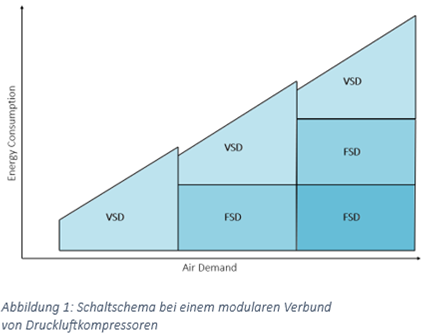Modularization - The way to more efficient use of air compressors in industry!
Dynamic demand of high-quality air, and rising energy costs are increasingly raising the question of how compressed air can be provided in a process-reliable manner with low acquisition and operating costs, while at the same time enabling energy efficient process and preventive maintenance.
Thanks to the standardized interfaces for the integration of air compressors, a modular concept can be developed using the Module Type Package (MTP), which combines the advantages of distinctive designs and drive types in a single system and meets the complex requirements for implementing control strategy with a minimum of development work during installation. MTP can be a way to develop better automation, supply and quality management, and maintenance concept to effectively design a system that meets peak requirements but also operates efficiently at part-load to achieve a high-performance compressed air system.
In a system with several compressors, a sophisticated control system is used to coordinate the compressors and the air supply to the system. A central control system coordinates all the functions required to provide and optimize the compressed air supply. An autonomous master control strategy provides various functionalities, including monitoring, controlling the components in the system, and collecting trend data to improve maintenance functions and minimize energy consumption and operating costs. The concept of this white paper is that two different drive types of air compressors can be combined in a network and their respective advantages can be used in combination to serve the dynamic demand. These two drive types are the Variable Speed Drive (VSD) and the Fixed Speed Drive (FSD).
The FSD compressors can regulate the operating pressure by means of switch-on and switch-off intervals (two-point control). However, due to the mechanical load during start-up, they cannot be switched off completely during the switch-off interval, but instead run idle. FSDs cannot handle frequent start/stop and are limited to four starts per hour to avoid damage to the motor. This type of compressor usually consumes 15-35% of the energy in idle mode and can therefore lead to poor efficiency in the event of unfavorable compressed air requirements (long switch-off intervals). Under full load, this type of drive has the highest energy efficiency.
The drives of VSD compressors are controlled by frequency inverters so that they can continuously adapt to the compressed air demand from a minimum flow rate and thus enable a stable operating pressure with constant energy efficiency. They also benefit from reduced stopping and starting stress due to the soft start facility and allows unlimited motor starts per hour. However, VSD compressors have a slightly higher energy requirement at the same delivery rate than FDS compressors at full load. In addition, the use of VSD compressors is associated with higher procurement and maintenance costs.
By modularizing air compressors, the advantages of both types can be combined – optimal design, minimal maintenance and acquisition costs, and the good efficiency of FSD compressors at full load with the precise and energy-efficient regulation of pressure by VSD compressors. Compressors with fixed and variable drive systems have dynamic energy consumption profiles. They require master control strategy to run the multiple compressors as a system. The control system with energy optimization reacts to the flow and pressure of the air output and determines which compressors need to be loaded and which ones need to be unloaded to have the most energy efficient configuration. Several FSD compressors initially serve the main load and can be switched on and off individually when the main load changes (no idle consumption). A VSD compressor can regulate the exact operating pressure via the residual demand. This enables the highest possible efficiency in the control of the compressors.




